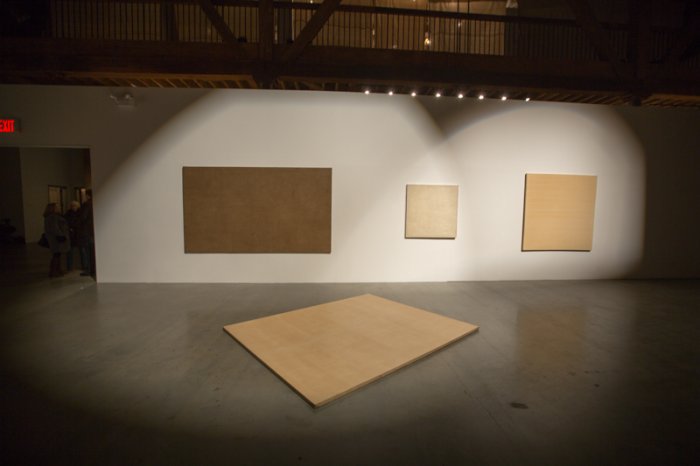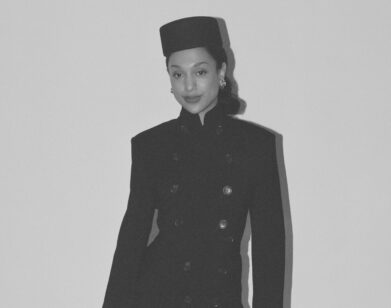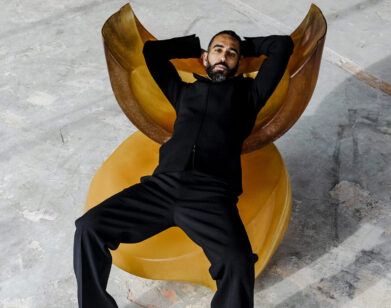Alanna Heiss, On the Horizon
The forsaken public school. The former jail. One abandoned warehouse after another. Most would see crumpled destitution; Alanna Heiss saw empty space. Over the last 50 years, Heiss has shattered the institutional limits of curating: she had the vision to fill the void, and the knack to know how to do so. Dozens of New York’s deserted corners in the late 1960s and early 1970s became, under Heiss’s direction, artist studios and arenas for exhibitions and performance. The school? P.S. 1 Contemporary Art Center, of course, today MoMA PS1. (“The anti-museum,” Heiss had imagined, though PS 1 is hardly that now.)
Heiss’s loftiest ambition was her Tribeca Clocktower Gallery. “I wanted it to be a kind of heaven,” she remembers of 108 Leonard’s Street’s top floors and rooftop. “Inapproachable heaven.” Heiss acquired the 10,000-square-foot space in 1972, turning it from a storage area to a gallery and artists’ residency. Above the public’s eyeline (and often heads), the Clocktower staged year after year of fearless, genre-defining shows—from Vito Acconci’s “Under History Lessons,” where viewers spoke with Acconci as though he were their student and teacher, to Gordon Matta-Clark’s “Clock Shower,” where the artist lathered up while dangling from the face of the clock.
In 1976, Heiss turned her focus to P.S. 1, knowing the massive edifice would require her full attention to make it the world’s best, which was her resolute goal. Yet as she shuttered other spaces, she couldn’t bring herself to close Clocktower. When Heiss stepped down from MoMA PS1’s directorship in 2008, she returned to it, fancying she’d spend the rest of her working days there. She moved Art International Radio (AIR), which originated at P.S. 1, to her new headquarters. The last five years have seen a number of musical collaborations and—all things considered, somewhat perfectly—a show by James Franco (whom Heiss incidentally likens to Andy Warhol).
It all threatened to fall apart when, reading in the paper one day, Heiss saw that Mayor Bloomberg was selling the building. Fighting to retain Clocktower would have probably proved futile. But Heiss wasn’t about to retire out of such an annoyance, however significant. Like in the ’70s, she set out to find new, interesting spaces in the city in which to keep Clocktower ticking. And since the ’70s, plenty have cropped up.
Dustin Yellin’s Pioneer Works in Red Hook houses the Clocktower’s first satellite show, a retrospective titled “Dale Henry: The Artist Who Left New York.” Henry, who died in 2011, left behind the money-driven intensity of 1970s Soho for rural Virgnia, subsequently fading into obscurity. He bequeathed his life’s work to Heiss under the condition it would never enter the commercial art market. Heiss will distribute the works to other artists when the show ends in February.
Also in the works for Clocktower are a series of pop-ups in Times Square and a show at Knockdown Center, a multipurpose venue in Queens. Heiss’s new office and AIR base will be in Gramercy’s up-and-coming multi-purpose collective NeueHouse.
Heiss was born in Kentucky and raised in Illinois. She studied music, but when her aspirations to be a classical violinist were dissuaded, a stint in New York’s rock-‘n’-roll scene helped her initially connect with artists. We met her at her Tribeca apartment, coming in from a sub-zero January night.
ALANNA HEISS: I don’t know you, Rachel, so I don’t know if you’re really an art critic or an art historian or a journalist or an arts journalist.
RACHEL SMALL: I’m an arts journalist. I was an art history major in college.
HEISS: So you’re a closet art historian disguised as a journalist. Knowing and learning about art of your time does not usually come through art historians. It comes through things we read about in newspapers. So that really means that the gatekeepers, to one learning to love art are journalists rather than historians. Journalists who care about art have a tremendous responsibility. That’s the end of the lecture I give you on journalism. Now let me give you a drink. It’s the end of a long day, Rachel.
SMALL: I couldn’t agree more.
HEISS: [laughs] And you’ve come at a frigid time. Let’s toast each other. To not being frigid. To the warmth of a creative.
SMALL: You briefly studied philosophy and aesthetics at the University of Chicago. What did you find interesting about that?
HEISS: The idea of discussing aspects of beauty. Those subjective qualities become quite interesting to a person in their 20s who’s trying to figure out what life is composed of and how it works.
Of course, since I was playing the violin and playing the piano, I didn’t actually have to think about thoughts about being beautiful. That was just something I did. Especially in the piano. The piano is quite useful, because it’s all in black and white—and that’s a deliberate pun. You play the note, you get the note. You miss the note, you miss the note, that’s it. The piano is just there, and that makes it the ultimately therapeutic issue. I think if therapy isn’t working, someone should buy a piano and start taking lessons learning Bach. Bach is a composer that makes everything regular. Bach says to us, “Rachel, if you learn how to play my song, your life will work out.” Bach takes us out of chaos, which is the terror. Bach says, “I can bring you out of chaos,” which is an extraordinary thing for an artist to do. Mostly in the art that you and I are involved with, Rachel, the artist says something very different, which is “Come with me, visit me in my room full of chaos.” That’s always a chance you take when you look at a work and you try to enter that work. If you’re really captured in that work, or captured in the room, you deal with the results.
SMALL: When I went to the Clocktower’s closing, every single space just—you became completely immersed.
HEISS: And [the art] asked you different questions when you were in that space. A connection between philosophy and the contemporary art is that most artists, when they make their art, ask questions. Philosophy is a study of trying to find answers. Artists are always pushing, pushing, pushing ambitiously to find out if they’ve wrestled the questions into the picture, if they’re really confronting them in an honest way. It’s quite different than being a sort of happy landscape painter and saying “It’s so cold, there’s the sun, everything’s right, and now you can be happy.” Well, you want to know what we’re doing now. When I started in the ’70s, I had pretty high ideas, I organized some shows. I wasn’t an artist myself, an important lesson early on [in music]. But I wanted to work with the best people of my generation, whoever they were, in any way that counted the most. So I made that my new mission. It was not hard to do particularly in music and in rock-‘n’-roll. I was in a band that played at the hot spots here in New York, called Justine and the Victorian Punks.
SMALL: That sounds tremendous.
HEISS: We wore very few clothes. When I came back to New York, I was very close to the artists and also to the musicians. I decided that, instead of struggling with the museum, I could do shows in factories and in industrial areas that would be much more appropriate for the work that was being done. It looked better there.
SMALL: Did you imagine that or did you sort of see an example?
HEISS: I thought it would be the most interesting experiment. I had this place on Bleecker Street across from CBGB’s. It was a burned-out warehouse. I did shows there and I put Philip Glass in studios there. He was my then-husband’s cousin. We lived together, actually.
Real estate is very attractive to me. It seems I can almost touch it. I could never sell it, but the qualities of real estate which make it space are interesting to me because art goes in that space, or doesn’t. I’ve spent half my life wandering around spaces. I was just grabbing these spaces in depressed New York. Every space had a different sort of thing.
The way we would get all our permits was by saying we were making films. If you say you’re making a film, you can do almost anything. The police are happy with films. They understand films because films are making money. Anyway, so I was involved with producing things within the spaces and I kept adding them. I didn’t drop very many because I’m very greedy, and it’s very hard for me to give up space. One of the spaces I gave up was—some of these were terrible failures, and this was one—a very attractive experiment. The city had an excess police station in Crown Heights, which was a huge battlefield. They were giving up the police station and turning it into a community center. But the community wanted them to stay because they needed protection. So I stupidly went in to take the upper two floors with the idea that we would bring artists and give them studios there. The studios were going to be the jail cells. It turns out, no one wants to be in a jail cell. Not anyone. Not if it’s free, not if you can walk in and out. The neighborhood people weren’t interested, and the police weren’t interested, and the artists weren’t interested. We did this huge parade, and people started throwing vegetables. I said “This is it, we’re out of this project.” We were gone. And I never, ever, ever, ever experimented inside penal institutions again. Anyway, I got so tired of being on the street, in these burned-out buildings, that I actually kept thinking I would really like to be in a tower and have this utopian place.
SMALL: What do you mean by utopia?
HEISS: It didn’t have any consideration of social welfare. Art for itself. I wanted to be on the top of the building. I found the Clocktower. And that was a stupendous place, and completely vacant, and just incredibly beautiful.
All the shows were done by me with only one idea, which was the artist, the single artist. There was no consideration of a public. Because you see, the Clocktower wasn’t on street level, so you never had to think about your public duties. You only had to think about your duty to art. That was pretty easy to figure out morally. It just meant being open and opening the doors and letting people see the work.
SMALL: I feel like it’s rare to have such moral clarity.
HEISS: Exactly right. People always went there and they were always in love and nothing ever happened. In the ’80s, it was harder because a lot of the artists were much wilder and they were involved more in drugs. I’m glad we got through the ’80s without any accident happening. I was mainly worried about someone falling off.
SMALL: How did PS1 come about?
HEISS: Each borough had made a request saying, “This is a building, we can’t take it on. With these artists that you work with and non-profit scene give us a living museum.” I looked at all these spaces in these different boroughs and I saw PS1.
When I saw it I was like “Oh my god, this is for us, this is the ultimate place. But to do this, I have to put away all these other projects. Because if I take it on, I need to do a really good job.” It wasn’t about commerce, or galleries, or collections or anything, but it was about challenging museums.
I closed or gave away the other alternative spaces, which was fine, except for one. I couldn’t bear to give up the Clocktower. I thought, “I’ll keep it until I need it.” So Clocktower stayed. When it came time for me to leave PS1 in 2008, I thought, “I know, I’ll go back to the Clocktower and I’ll do all those strange, weird shows that I wanted to do that weren’t right for PS1. I could just do anything in the world that I wanted to.”
I took the radio station, which I started in 2003, and I’ve always put the station at the Clocktower. I thought “This’ll be a perfect world. Perfect. Klaus, my protégé, my best friend, and everything that I admire and love, will take on PS1 and will do this great job,” which is true. We’d worked together for 20 years. He’s my puppy and my friend and my beloved everything. So this was the perfect world. I was going to be at the Clocktower. That’s how I expected I would end my days, shambling back and forth to the Clocktower. And then I opened up the newspaper and saw that Mayor Bloomberg was going to sell the Cotter Building. I was dumbstruck. All my life, I thought I had the Clocktower.
I realized, “So this is a time to either gracefully close,” which was probably the better option, “or not.” I said to myself, “Let me go around and look at spaces and see if there’s another space that’s really exciting to maintain and I’ll make the decision based on that.” So I started visiting other spaces and other people. Then I was talking to artists with spaces and thinking “Could I work with these people? Could my team?” So we started hammering out these kind of collaborator motions. And each one is different, and temporary. With Pioneer Works, it’s one year, an institutional residency, as if they had an artist at an institution. The radio will be centered there, in touch with the artists of that area [Redhook, Brooklyn]. It’s a beautiful space and it looks like fun.
SMALL: And fun people.
HEISS: And fun people. People who want to do something different. Dustin is a fun guy. All of these arrangements, there’s really little to no money involved. It’s trading information and talent and effort and things like that. It’s all traded ’round and ’round. So let’s drink again, to all the spaces…
SMALL: [toasting] To all the spaces.
HEISS: … that are going to be, one way or another, and experimenting in them. It’s so much fun to be working with people and places that don’t have to succeed. [laughs] It’s the idea of doing something interesting with interesting people, and then you grow from there. Or other people pick it up and they take it from there.
SMALL: You’re not worried about achieving a goal, you’re just doing it?
HEISS: Well, you may be achieving a goal, it’s just you’re not worried about an overall program that makes your institution a thriving institution. Financially, aesthetically. I mean, running PS1 all those years, it was a wonderful place, but also I had all those huge, huge responsibility to make the whole place reflect what it should and could do. It had to be the best place in the world. By square-footage, we were the biggest in the world. But there’s a place in Germany, in Hamburg, it’s very, very big. Its director wrote me and he said, “I think we may have more square feet than you.” I said, “I think you’re wrong.” Then he roofed over his parking space next to the museum and he sent me a picture of this. Added 550 square feet. And I looked at that, I was just …. He was right. So quickly, we built a much larger lift for loading art in and out of the trucks. It wasn’t for cars, it was for my art-loading trucks.
SMALL: Much more important.
HEISS: Much more important. Wish us a good year.
SMALL: Nothing but the best.
HEISS: And come along for the ride.
FOR MORE ON THE CLOCKTOWER GALLERY, VISIT ITS WEBSITE.







